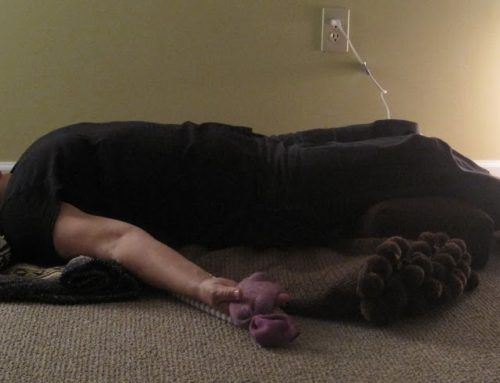There may have been a little more of silent sighing out yesterday during class – a few of you falling deeper into relaxation, less holding yourself up, and perhaps more space to heal. I feel grateful that each of you come back to your mat/bolster/blankets each week.
I grew up listening and watching to the Monkeys. Yes I am a child of the seventies (my informative years). Do you remember the song Daydream Believer? I do and of course Davey Jones’s dreamy eyes. I found this short article from Dr. Weil on daydreaming and how it too begins to activate the Relaxation Response just as our Restorative practice does. You may either want to keep your eyes closed or have your eyes soft at half mast when daydreaming. (DrWeil.com)
 |
 |
| Friday 09/13/2013 |
Join the conversation! |
|
 |
|
Why Daydreaming May Be Good For You!If you thought daydreamers were just wasting their time, think again. Harnessing the power of visual
imagination is an efficient and enjoyable way to activate the relaxation response. So get in on the
daydreaming action: Try picturing a place from your past, where you felt happy, secure, and peaceful.
Then imagine yourself there, making all the sensory impressions – smells, sounds, sights – as sharp as
possible. It’s a simple, cost-effective way to feel happier and calmer in no time.
|
The Inspiration – Sankalpa
Give your New Year’s resolutions a yogic twist—set an intention and infuse the new year with positive change.
A new year’s resolution is a noteworthy concept—start off the year with a change for the better. So how did it devolve into a subconscious exercise in self-loathing? Lose 10 pounds! (Message to self: You’re fat.) Stop drinking caffeine! (You’re unhealthy.) Call Mom and Dad once a week! (You’re ungrateful.) Why not celebrate this new year by trading in your tired (and probably familiar) resolutions for a sankalpa instead?
POSITIVE POWER A Sanskrit word, sankalpa means “will, purpose, or determination.” To make a sankalpa is to set an intention—it’s like a New Year’s resolution with a yogic twist. While a resolution often zeros in on a perceived negative aspect of ourselves (as in, “I want to lose weight, so no more chocolate chip cookies or ice cream or cheese”), a sankalpa explores what’s behind the thought or feeling (“I crave chocolate chip cookies or ice cream or cheese when I’m feeling stressed or sad. I will set an intention to become conscious of this craving and allow my feelings to arise and pass, rather than fill up on fats”).
EFFORT COUNTS A sankalpa also praises the nobility of the effort rather than focusing on what you are doing wrong. “New Year’s resolutions leave me feeling guilty and mad at myself for not keeping them,” says Wendy McClellan, a yoga teacher in Louisville, Kentucky. So, last year, in a conscious effort to reject the resolution rut, she taught a special New Year’s Eve yoga class and encouraged students to look back and let go. Her intention, or sankalpa? To open her heart to new possibilities. “An intention has much more of a global sense than a resolution,” she says. “It helps me be softer with myself.” With a sankalpa, the self-loathing that comes from dwelling on past transgressions can begin to dissolve. In its place is an exercise in effort and surrender—create an intention and open yourself to the universe.
Sankalpa Setting
LOOK INWARD For several days, set aside time to write in a journal and meditate. Mull over your typical resolutions. How do they make you feel? Anxious? Unsettled? Incomplete? Now contemplate how you would like to feel during the coming year. Is there any way you can reframe your results-oriented resolutions into something that will make this year’s journey more joyful and worthwhile?
REPHRASE IT Create a short sentence or phrase for your sankalpa. Be careful not to set limitations based on fear. For example, instead of “May life bring me only happiness and joy this year” consider “May I be happy and open to what life brings me.”
BE FIRM BUT FAIR Change doesn’t happen overnight. When you stray from the essence of your sankalpa, don’t berate yourself. Instead, gently remind yourself of your intention. But be firm in your resolve—it’s a good idea to incorporate your sankalpa into yoru daily routine. Use it as a mantra during pranayama or meditation practice; post it on your computer, phone, or mirror; or simply say it to yourself quietly before going to sleep. —C.G
Catherine Guthrie is a writer and yoga teacher in Louisville, Kentucky, and a regular contributor to Yoga Journal.
The Poses
Mountain Brook
Props: 2-3 blankets, neck roll, two bolsters
Benefits: counteracts the slumped position of our posture from sitting, computer use, driving, everyday activities. Opens the chest to help breathe easier. Improves digestion, reduces fatigue and can lift your mood.
Just like a babbling brook with boulders (soft ones!), imagine your body like the soft rushing waters laying over those boulders, smooth, flowing. It will allow the natural curves of the body to be held up gently and the breath to flow.
On your mat, place one bolster where your knees will be and another where your lower legs can rest, one blanket rolled up where the bra line is (base of scapula), and a neck roll for the cervical spine. Shoulders rest on the floor, arms to side with palms facing up or come into Goddess arms. If ankles need support, use rolled-up blanket or dish towel. Eye pillows can lightly rest on eyes or even be used on forehead (useful for headaches) or even on shoulders (wherever you need to release tension). To begin with stay in pose for 10 minutes working up to 20 minutes. Great to use in savasana. Feel the heart open, the strain from holding yourself up all day evaporate.
Variations: Feeling cranky in the lumbar spine? Place blanket to fill the curves. Want to feel more grounded while still opening the heart? Place rolled up blanket against wall and soles of feet touching blanket. Need to feel cuddled? Swaddle your head in a blanket cradle.
Wide Angle Forward Fold (Upavishta Konasana)
Props: bolster, two blocks, 4 or more blankets
Benefits: releases the pelvis which can help release tension in the buttocks, hips, belly and lower back. Quiets the organs of digestion and elimination. Opens lower back area. As head rests on bolster, releases tension in frontalis where we hold stress in contracted state. Cooling and calming to overall body and provides a nice transition from day. Can help with sleep.
Depending upon the length of your torso, you may or may not need the blocks under the bolster. A double-folded blanket folded over one more time adds height and comfort. Place as many of these as you need on top of the bolster. Cushions and pillows are also good. You will straddle the props bringing them in as close to your body as possible to support you as you forward fold. Rub hands together to warm up the hands and gently cup them over the eyes and rest on the elbows on the bolster. Avoid too much pressure on the eyes. To lesson any strain in the lower back, sit on a single or double-fold blanket. Can add blanket rolls under the knees. Stay for 5 to 10 minutes.
*note that for some students the breath can be constrained. Practice belly breaths to begin with.
Props: bolster, 3 blankets, 1 extra blanket for warmth and or laying on lower back to ground
Benefits: Gentle twist for the spine (quadratus lumborom) Releases stress on the back muscles and a stretch to the intercostal muscles. As muscles relax, breathing is enhanced.
Set one bolster lengthwise on your mat. Depending upon your comfort, height can be elevated with blocks under bolster. Lay one blanket on top double-fold and one double-fold at end of bolster where your right hip will go. Sit next to bolster with your right hip touching it, bend knees, left or top ankle can lay in arch of right foot or other comfortable position for feet. For added comfort, place blanket between legs. Lengthen body over bolster, laying bent legs in one directions and upper body facing down on bolster. Arms drape down sides of the bolster.






Leave A Comment